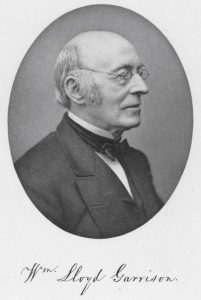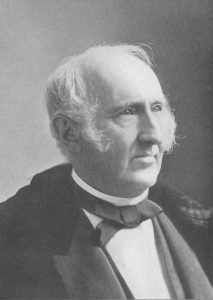By Susan Martin, Senior Processing Archivist

Many historians have written about the mob attack on William Lloyd Garrison on 21 October 1835. But some details of the infamous event—the attempted lynching of one of America’s most prominent abolitionists, right in the heart of Boston—were hotly contested by eyewitnesses.
A letter by John Hill Thorndike, written 34 years later, paints a vivid picture of what happened that day and shines a light on one important figure in the story, the mayor of Boston, Theodore Lyman.
On the afternoon of 21 October 1835, Thorndike, a young lawyer, was walking to his office on State Street when he heard a commotion and went over to investigate. A meeting of the Female Anti-Slavery Society, featuring Garrison, had been overrun by angry pro-slavery rioters who gathered outside the building, tore down the sign, and demanded Garrison show himself. Garrison tried to escape out a back door but was seized by the mob, and what Thorndike saw next was chilling: “There was a rush of some dozen men close together […] and in their midst a bare headed man with a rope round his neck.” This man was Garrison.
Garrison was saved through the intervention of Mayor Lyman and others, who rushed him into the Old State House. (The very site, coincidentally, of the Boston Massacre 65 years earlier.) In his letter, Thorndike described Lyman’s declaration to the rioters from the entrance of the building: “You can come no further, and any man who passes here will have to pass over my dead body.” Later, from a second-story window, he “ask[ed] them as good citizens to disperse, which they did.”
The fact of Lyman’s intercession is undisputed. But not all bystanders saw it the same way.

Wendell Phillips also witnessed the attack and was equally horrified at what he saw. However, his interpretation of Lyman’s role was less generous than Thorndike’s. In a 1869 lecture, he characterized the mayor not as demanding peace, but as pleading for it, “metaphorically speaking, on his knees to the mob.”
Mayor Lyman died in 1849, but his son took up his cause. He wrote an angry letter to the Boston Daily Advertiser arguing that his father would never have behaved that way and accusing Phillips of defaming a dead man. Phillips’ fiery reply was also published in the Advertiser:
[Theodore Lyman, Jr.] was in his cradle that day. I was in Washington Street. I saw his father beg and sue; I heard him beseech and entreat that mob to disperse and preserve order. He never once commanded or sought to control it. […] I saw him consent, if not assist, at tearing down the antislavery sign and throwing it to the mob, to propitiate its rage. The city was mine as well as his, and I hung my head, ashamed of it and him.
[…]
Twenty years ago I said, “The time will come when sons will deem it unkind and unchristian to remind the world of acts their fathers take pride in.” That hour has come.
It was, in fact, this account in the Advertiser that prompted Thorndike to write the letter quoted above, addressed to Lyman’s son. (For more details of the dispute, see Papers Related to the Garrison Mob, edited by Theodore Lyman III and published in 1870.)
It’s true that Mayor Lyman was no friend of abolitionists. But it wasn’t just his tone that Phillips took issue with. He criticized Lyman for breaking up the meeting of the Female Anti-Slavery Society and ordering its members, who were legally assembled, to disperse. The mayor also arrested Garrison for disturbing the peace and none of the rioters, though he claimed it was for Garrison’s safety and the abolitionist was released the following day.
The details of Phillips’ story were corroborated by William Lloyd Garrison himself, in an article called “Triumph of Mobocracy in Boston,” published in his Liberator newspaper shortly after the attack. A copy of this article is included as an appendix in Selections from the Writings and Speeches of William Lloyd Garrison (Boston: R. F. Wallcut, 1852).

